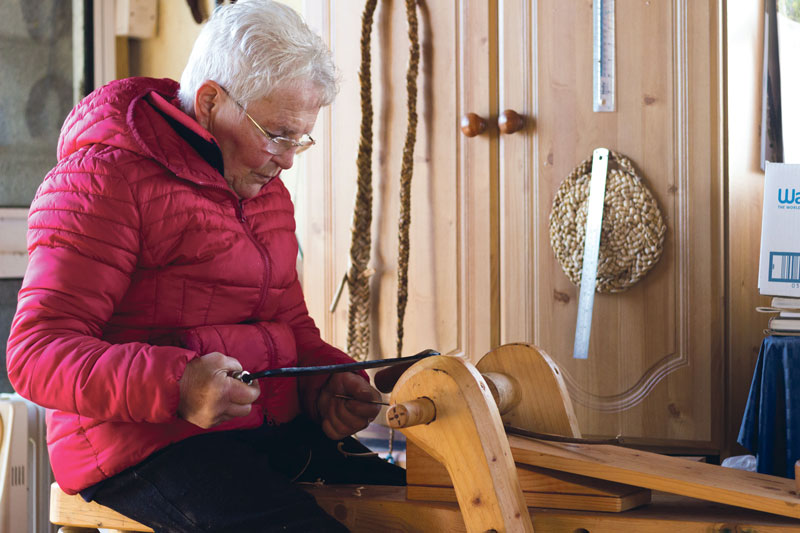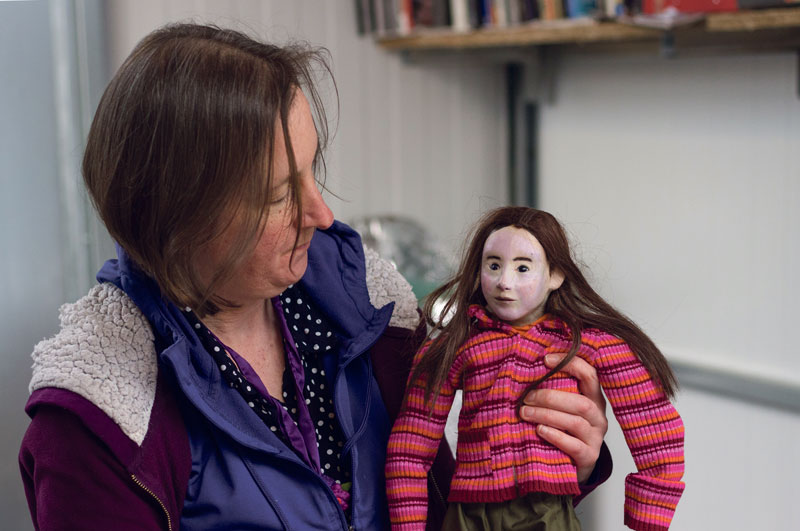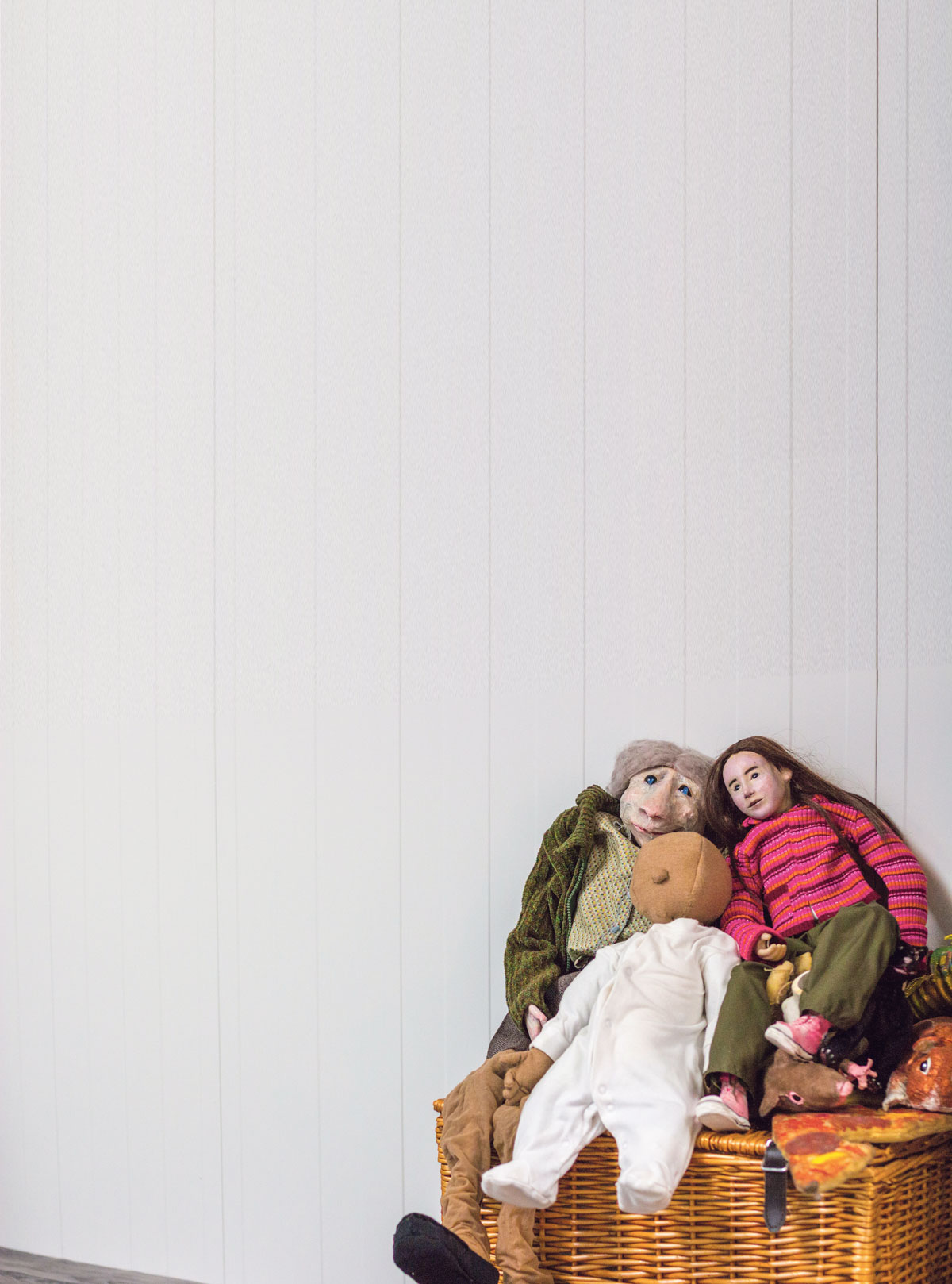There is a rumour in my family that my great grandma’s brother was once a taxidermist, and my mother’s uncle was a great wood turner in his day. My aunt used to teach me knitting and crocheting when I was little. I used to practise a lot until I learned how to use the computer. Truth be told in a lot of Irish households, amidst the flatpack furniture, there sits that awful coffee table or chair that your grandad made – eyesore that has been impossible to co-ordinate with any IKEA colour scheme or even modernise with a lick of paint. For as long as you can remember, it has been passed from family member to family member like any unwanted heirloom. It was in your room at one stage, you think, but eventually made its way into the shed. It has become a member of the family in its own right – annoying and irritating, but God, if you ever threw it out.
These dying arts still exist, dotted across the country behind closed curtains, backroom sheds and one-room factories.
Tucked away in a housing estate in Lucan lies the workshop of Michael Dunne, a taxidermist and chairman of the newly established Taxidermy Association of Ireland. The house is unassuming, like most family homes. However, the moment you step inside you realise that there are a lot of eyes on you. Preserved pheasants, deer heads, foxes, chicks, geese, fish and many other animals, are mounted and displayed on any spare shelf, wall space or mantlepiece available.
The upstairs front bedroom resembles a scene from a storage room in the Natural History Museum, with shelves upon shelves of perfectly preserved animals. Ever since he was a child, Dunne has always loved animals, fishing and collecting bird eggs. He owned many animals of his own, and jokes that he ran his own little zoo. “I used to charge the local kids into the zoo”, he laughs. “I had a rabbit, a tortoise, I had birds.” After losing his job over 10 years ago, Dunne decided that his passion and love for animals meant that he was suited to the role of a taxidermist. After training in the UK, he returned to Ireland and opened his own taxidermy business, operating out of a workshop in the back garden of his home in Lucan.
How are you going to get the skin off them, to get the bone out?
Inside the workshop, various tools, knives and scalpels line the walls. Two owls sit proudly in a display case in front of me, staring down at my gaunt expression as I take in my surroundings. A dead, skinned cat lies on the workshop table, its fur coat floating in a container of preservatives at my feet.
Dunne outlines the process to me. After receiving a dead animal, it is usually placed in the freezer until Dunne is ready to work on it. If it is left out too long, “it starts drying up, and you can’t bend it any particular way”. Once out of the freezer, “you open it up and take the skin off” and remove the fat. “You wash it and half dry it, and turn it inside out and put the preservative on it.” It often takes two weeks for the preservative to seep into the coat of the animal, and in this time, using measurements and reference pictures of the animal, Dunne replicates the legs, wings, head and body of the animal using straw, wire and wood, to create a mannequin of the animal which the coat will be later attached to. For every animal, there are different techniques and tricks used.
Take a squirrel. “If you put a squirrel in the freezer, the legs are so small that they can shrivel up and dry up”, notes Dunne. “How are you going to get the skin off them, to get the bone out? You get a syringe with a drop of warm water, not soapy just ordinary water, and just inject it in and squeeze up and you’ll see the leg going like that. It’s unbelievable. Do them all, come in and have a quick cup of tea for 15 minutes and go down and there they are. The skin would just come off them.”
Dunne explains how he uses a similar method to measure the distance between the two eyes of an animal. An animal’s eyes are sunk in their head, “so if you get a syringe with nothing in it and you just put it in behind the eye through the mouth and you just squeeze it, the eyes will blow up with the air and then you can measure the distance” between the eyes. All of this is done to ensure that the preserved animal resembles how it looked when it was alive, which is one of the major priorities for any good taxidermist. Each year at the World Taxidermy Championships, taxidermists are judged on how lifelike their works are. “Feather out of place, the judges would cop it”, asserts Dunne.
There is one animal, however, that Dunne refuses to preserve – a dog. His decision came after an experience he had when he agreed to preserve a dog for a client. The client travelled on two buses to come and see Dunne and give him the body of her deceased pet. “I met her at the bus stop and when she got off the bus I knew it was her straight away”, says Dunne, “because she had a bag on her back, which obviously the dead dog was in”.

“To be out in the weather we have had recently harvesting willow is inhuman”, says McCormick.
“She took the bag off her back, I opened up the bag and I could tell you, I never smelled anything like it in my life. The dog was rotten. The head was hanging off the dog by a thread. She informed me that the dog was attacked by her other dogs she has, and they killed it. Tore it asunder. Full of blood and everything and matted and everything. ‘That’s it,’ I said. ‘Take it away,’ I said. ‘It’s gone too far.’ She left it in the bottom of her fridge for about a week, in the bottom of her fridge with the milk and the cheese and all that carry on. That was the nail in the coffin.”
Dunne admits that he believes that preserving a dog “is a bit silly,” and if he could, he would rather just preserve birds. “If a taxidermist finds a bird and preserves it, it lives on in a different way”, he muses. “You are showing respect for it, rather than leaving it there to rot and decay or throw it in the bin as a piece of dirt. It becomes something that can be admired or looked at.”
“I had a woman here who I done a parrot for, and she was a clairvoyant. And when she came into the house, she said she could feel [the animals]. She said, ‘This place, they are running around, foxes and everything, running around here, you know that?’” says Dunne. “She said ‘your mother, she’s very proud of you because you always loved animals. You wanted to be a vet in another life. Whatever happened, you just didn’t make it as a vet. This is another way of looking after these animals. You’re looking after them in a different way.’”
And for Michael Dunne, looking after animals has always been at the heart of his craft.
Buried in the rolling fields of Broadford, Co Kildare is Basket Barn, Kathleen McCormick’s home, willow farm and basket-making workshop. She began growing willow around 10 years ago after beginning a series of basket-making courses with Joe Hogan, an internationally renowned Irish basket maker. Now she is a seasoned willow worker, having won first prize in the RDS crafts competition and has travelled to craft fairs and courses around the world to learn new techniques and skills. Inside her house, countless willow baskets hang from hooks on the walls. The fire is lighting and the kettle is boiling. As she unpacks her groceries and pours us two cups of tea, she assures me that everything in her house, every piece of furniture was handcrafted by either herself or somebody she knew, and over the course of 20 years she has built her house and made it a home, which she shares with her dog Teddy. It’s difficult not to admire the fierce pride audible behind every word she speaks.
“Practically everything in here is either my work or someone else’s I know well, or something I’ve made on a course”, she explains. “I don’t sell anything I’ve made on a course unless I didn’t like the teacher and then I can’t wait to get rid of it. I don’t want negative things in my house.”
Coming from a family of woodworkers and craftspeople, McCormick always knew she wanted to pursue basket making. In her youth, she used to sew for money to help pay the bills and basket making always felt like a natural progression for her. Now the jobs and commissions keep rolling in, with McCormick and her farm always kept busy, so much so that she often passes on jobs to other basket makers. “I’m getting old, and I’m not going to kill myself”, she tells me firmly.“I’ll do my best, but not kill myself doing something I find difficult. I’ll just pass it on to some whippersnapper, anxious for jobs and money.” However, McCormick does admit that the competition amongst basket makers can be fierce: “One man [a basket maker] lives in the village beside me and I just have to watch my back. He says I’m hard on him, and I say not hard enough. Then when he looks at one of my baskets he’d say, ‘that won’t do’, and then he laughs. So there is healthy competition. But he has his clients and I have mine and there is enough work for everybody.”
McCormick also runs basket making courses on a one-to-one basis out of her home and says she “puts her heart and soul into it”. The only people she finds difficult to teach are a husband and wife. “I find there is competition between them and I make it quite clear that I won’t have it”, she laughs. “And they get to know the dog and the hens and they go home with eggs.”
McCormick takes me out to the willow fields around her house. I struggle to climb under the fence and walk through the mud. “You’re a city girl”, she laughs.
My attention is drawn to the largest basket in the room. Looking closer, I realise it’s a coffin
Once the willow is harvested, any stunted or diseased willow is discarded, and the remaining willow is de-branched and stored outside for 10 weeks. It is then soaked in water to ensure it is supple and easy to bend. She laments the physical challenges of the job: “To be out in the weather we have had recently harvesting willow is inhuman.” McCormick’s hands are evidence of these hardships, weathered by arthritis, beaten and toughened by willow working. She insists however that they are pain-free. The outside walls of her house are lined with bundles of willow, many of them two or three feet taller than myself. The bunches are of a variety of colours, green, yellow, orange, red and purple. I ask her how she gets them to be those colours and she replies simply with, “God does it”. Later she would tell me proudly that she does not use any dye to colour her willow.
Inside her workshop, baskets are piled up in every corner of the room. She points to a large one, a log basket, in the back corner. “Log baskets last forever”, she smiles. “You have to put in your will, who you are going to leave it to because you will still have it. It won’t deteriorate. It won’t rot, it won’t disappear.” My attention is drawn to the largest basket in the room, lying across the top of a set of cabinets. Looking closer, I realise it’s a coffin. McCormick sees me gazing at it. “That’s mine”, she laughs, before bidding me well with six freshly laid hens eggs.
In Sallynoggin, Dublin, I find a craft that’s just as mystical, in its own way, as willow-weaving. Niamh Lawlor has finally built her own puppet-making workshop and performance studio. Like Dunne and McCormick’s, her workshop is located in the back garden of her home. After studying in the National College for Art and Design (NCAD) and receiving a master’s in directing for theatre in the University of Hull, Lawlow was part of a group that founded Púca Puppets in 1997. Today she runs the business entirely on her own and is a self-proclaimed “one woman show”. She explains how after finishing her education, she flirted with the idea of pursuing acting, however still had a passion for writing, designing and making. It was then that she discovered that puppetry was a “meeting ground” for all of these things, a “collaborative theatrical medium” that really can turn out to be “something quite powerful”. Puppets are “metaphors and very powerful symbols”, she tells me.

Puppets are “metaphors and very powerful symbols”, says Lawlor.
For the last 21 years, Lawlor has written, created and toured puppet shows nationally. Whilst the majority of them have been tailored towards children, Lawlor has created shows for adults. One of her most popular and well-received shows was called Mary Mary’s Last Dance, which tells the story of an “older woman on her last night in the world”. Lawlor recalls how at the end of each show when the theatre went dark, she would hear faint sniffles and cries coming from the audience. She recalls how people were surprised by how emotionally invested they became in a character that was played by a puppet. Lawlor believes this is due to the power of our imaginations, a power that many adults forget they still have. “Theatre is always an act of imagination between the audience and the people on stage”, says Lawlor. “And actually the audience love to be challenged a little bit, they love that they are colouring in those dots.”
“There is always a presumption that a puppet show is only for children, which I take offence with on two fronts”, says Lawlor. “First of all, it isn’t only just for children. Actually, children are a really demanding and challenging audience and should be given a respect as an audience. People tend not to give them respect, [the shows] tend not to be as well funded, they tend not to be acknowledged as much, that the work needs to be good.”
Whilst Lawlor bases a lot of her children’s shows on old fables, she also writes them from scratch after she is “bitten by an idea” during a moment of inspiration: “I did a show about my daughter growing. She was an infant at the time. I was thinking it’s going by so fast. How can this person not have existed and now they are crawling around the room speaking to me, in the course of two or three years? This is mad, this is amazing, how do I hold on to it?”
Lawlor insists that puppetry is not a dying art, despite the rise in technology both inside and outside the classroom. She argues that children will continue to need something to create and then project themselves onto. “A puppet can say things that you were finding it hard to say”, she explains. “Children will always get excited by them, they’ll always enjoy them. I suppose it is up to us to keep providing them.”
Today, Lawlor delivers workshops to trainee teachers at NCAD and Marino College of Education, teaching them how to make puppets and use them as teaching tools in the classroom. She also hopes to begin running workshops out of her own new studio and has two new shows touring early next year. As she outlines her plans, Lawlor can’t contain her smile. “I am still in love with them”, she laughs. “I am still in love with puppets.”
A love for their craft is what drives people like Lawlor, McCormick and Dunne. “I really believe”, says Dunne, “that whatever career you take up, if you’re not interested, there is really no point”.







